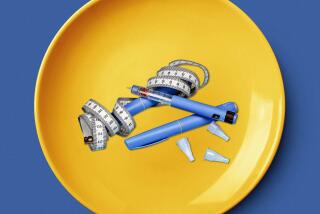Personal Health : Slim Chances : Personal Health: In the quest for thin, the badly misguided have resorted to crack and cocaine. Drugs are increasingly being linked to eating disorders.
NEW YORK — The idea came to Debra when she noticed she was gaining a few pounds.
“I thought I could do some crack and get all thin, lose my stomach but keep my butt,” she says. “I thought I could stop.”
But six months later, Debra was addicted. Crack had become the driving force in her life. “I was turning tricks for drugs, going through the motions, doing what I had to do with my supplier,” she says.
Doctors and users say there is a new reason behind the use of crack and cocaine among girls and young women: The misguided, but growing perception that it is a quick, cheap and easy way to lose weight.
Drug use also increasingly is being linked to eating disorders such as bulimia, where people often of normal weight binge and force themselves to vomit before the food is digested, and anorexia nervosa, in which underweight, often emaciated people refuse to eat. Drug dealers, recognizing a new market, have begun dangling the panacea for ideal weight as a sales pitch. One 10-year-old girl says she was walking down 134th Street in New York recently when a pusher tried to sell her some crack.
“He said that boys only like thin girls like (Cosby show actress) Lisa Bonet,” she says, looking down at her small feet. “I want to be like Lisa Bonet.”
Vicki Greenleaf, author of “Women and Cocaine,” observes: “Cocaine has no boundaries.”
Although crack, a mixture of cocaine and other substances, is more common among poor drug users, and the purer form of cocaine is primarily used by wealthier users, the new form of dieting cuts across all class and ethnic lines.
Cocaine counselors usually blame curiosity, peer pressure and a desire to escape responsibility as the main reasons for drug abuse.
But Kristen Gayle, 11, of Harlem says, “My friends don’t do crack to get out of responsibility. They do it to get all skinny.”
Dr. Michael Newman, director of the eating disorder unit at Fair Oaks Hospital in Summit, N.J., estimates that 40% of the patients he treats have a history of cocaine abuse. One-fourth of the patients entering his unit have severe addictions at the time they enter his eating disorder clinic, Newman said.
Within the last year, Fair Oaks has joined a number of hospitals nationwide that have modified their programs to treat both eating disorders and drug addiction at the same time.
“Cocaine is an anorexic drug,” says Dr. Lester Grinspoon, professor of psychiatry at Harvard Medical School and author of “The Speed Culture,” a book about amphetamines, and “Cocaine and Its Social Evolution.”
Although cocaine use does not necessarily lead to eating disorders, Grinspoon says, the drug reduces weight because it is an amphetamine, and, therefore, suppresses hunger by stimulating the central nervous system.
“Crack deceives the senses,” Dr. Newman says. “It makes the user feel fed and well-rested,” and as a result “the user can go for days without food.”
“Some go on cocaine binges in order to lose their appetite,” he says. “Many report that they didn’t feel good taking crack, but that it was OK because they did not eat for days.”
Denise, 32, who is recovering from her drug addiction at the Veritas Therapeutic Community Center in New York, is an example. “I could go for a week on one meal,” she says. “Crack made food taste nasty. You had to force yourself to eat. I thought that was good.”
The drug also speeds up the body’s metabolism, but it’s the appetite suppressant that is most dangerous, says Ed Poska, a counselor at the Washington Institute of Drug Abuse in Manhattan.
Michael Meyers, medical director of Choices at Brotman, a private eating disorders clinic in Los Angeles, estimates that 50% to 70% of all people suffering from eating disorders have a history of substance abuse. Treating one illness while neglecting the other is ineffective, he said.
One recovering anorexic-bulimia patient, for example, says she suffered a relapse in her cocaine habit because of her eating disorder.
“I didn’t know what an eating disorder was then,” she told Greenleaf. “But I did believe that if I didn’t have cocaine, I’d get fat.” The day she finished treatment for bulimia, she said, she went back to drugs.
Dr. Sheila Blume, director of South Oaks Hospital in Long Island, who has specialized in female addiction for 28 years, says there is a strong connection between cocaine use and weight loss in women.
Most cocaine users are ages 18 to 34, the same age group which is most prone to eating disorders. Of these users, one-third to one-half are women, according to Blume.
Men seldom think about drugs as an avenue to weight loss, she says, “but women do. Women are concerned about their looks and weight and keeping up with the latest fashion.”
With women who hold those values, cocaine may seem “the perfect ladylike drug,” author Greenleaf notes. “There are no unsightly needly marks, no smells. You don’t have to hang around bars. It’s slimming, it’s sensual and you don’t slur your words. You can carry it around in your cosmetic case just like a lipstick.”
Greenleaf also blames doctors for giving women the impression that drugs are a good way to take off a few pounds. Overweight women are 50% more likely to be prescribed diet pills and tranquilizers than men, who are generally told to exercise and eat right, she said.
One recovering addict said the first drug she took was an over-the-counter diet pill. Ultimately, she turned to cocaine.
There is some evidence that men also may be turning to drugs for weight loss. Dr. Jeffrey Jonas, another Fair Oaks Hospital physician, found that among 259 consecutive callers to the National Cocaine Hotline, almost one-third met criteria for anorexia nervosa, bulimia or both--and half of those diagnosed were men.
At first, cocaine may seem like “the magic cure,” Blume says. “Cocaine gives you that euphoria and suppresses your appetite.” But the intense high can lead to addiction within a week, or even after the first smoke, some experts say.
Even crack addicts who try to maintain normal eating habits are likely to lose weight. Poska notes that at the Washington Institute, which treats mostly middle-class professionals, “the patients lost between 10 to 50 pounds while they were addicted to crack.”
In poor neighborhoods, where addicts are generally less intent on hiding their addictions because drug use is so prevalent, weight loss can be even more drastic and severe.
“I was like a toothpick,” says Dorothy, 17, a svelte, 5-foot-7 recovering addict who entered the Veritas House at only 98 pounds. “A year ago, I was like one of those anorexics,” she says. “You could see all my ribs.”
Poska explains that smoking crack, rather than snorting cocaine, is generally preferred by women who use the stimulant to lose weight because “ingestion is quicker, and it has a magnified and accelerated effect on the pleasure centers of the brain,” which convey the body’s need for food and water.
Low cost is yet another attraction of using cocaine to lose weight, according to a counselor on the Substance Abuse Hotline in New York. “It not only suppresses the appetite, it’s also cheap,” she says.
In many neighborhoods, for example, a small pebble or packet of crack sells for as little as $2, which is less than the price of over-the-counter diet pills that cost anywhere from $5 to $10 per packet.
“There are girls I see on the street stopping men for $2 (sexual acts) just for a quick fly,” says Carmen, 30, a recovering addict at the Veritas House in New York who eventually hopes to counsel juvenile drug abusers.
As many recovering cocaine users have found, cocaine often affects bodies in ways substance abusers cannot see in the throws of their addiction.
It turned out that Debra was gaining weight because of pregnancy rather than overeating. When ambulance attendants wheeled her into the emergency room for what she thought was a batch of bad cocaine, doctors found she was about to give birth.
“I didn’t know I was pregnant until I was in labor,” she says shaking her head.
Debra’s son was born addicted to crack.


